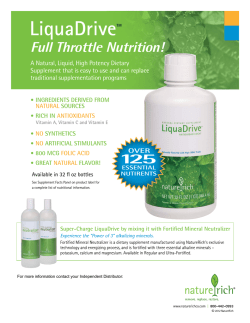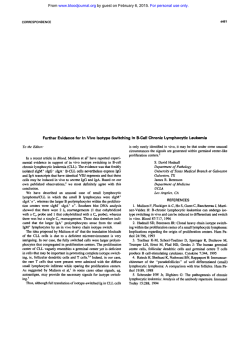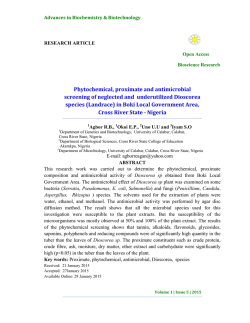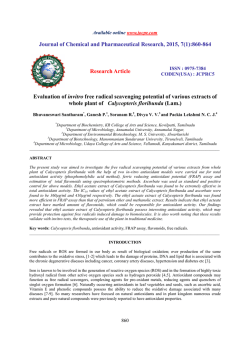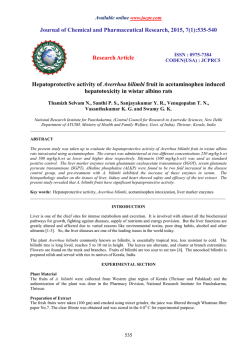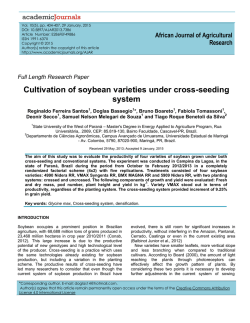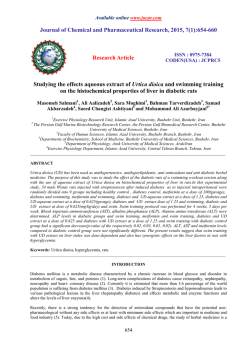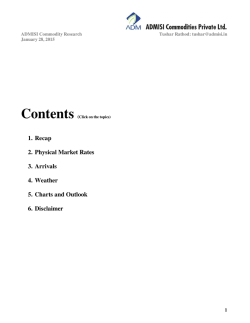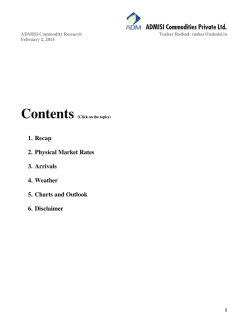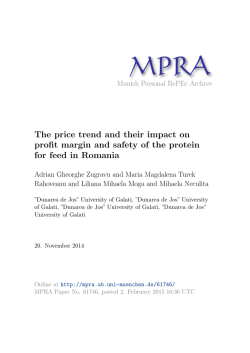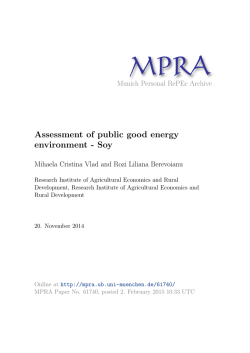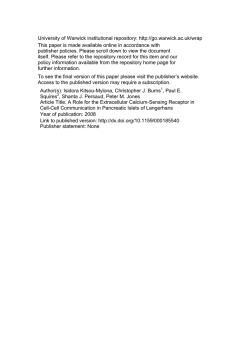
Osteoblast cell proliferation activity of isoflavoneaglycones from
Available online www.jocpr.com Journal of Chemical and Pharmaceutical Research, 2015, 7(1):781-784 Research Article ISSN : 0975-7384 CODEN(USA) : JCPRC5 Osteoblast cell proliferation activity of isoflavone aglycones from fermented soybean by Lactobacillus acidophilus Muammar Fawwaz1* and Wahyuni2 1 Departement of Pharmaceutical Chemistry, Faculty of Pharmacy, Universitas Muslim Indonesia, Makassar, Republic of Indonesia 2 Departement of Pharmacology, Faculty of Pharmacy, Universitas Halu Oleo, Kendari, Republic of Indonesia _____________________________________________________________________________________________ ABSTRACT This study aims to obtain isoflavones aglycone as genistein form through the process of fermentation of soybean by probiotic bacteria producing ß-glucosidase namely Lactobacillus acidophilus. Isoflavone aglycone obtained then testing the activity of osteoblast cell proliferation in vitro by MTT method that will be read by ELISA. Fermented in the extraction with ethyl acetate. Liquid extract was evaporated with a rotary evaporator and lyophilized by freeze dryer. Extract 3 mg in 10 ml of 80% methanol in UFLC analyzed its genistein levels. Comparators are used genistein standard ≥ 98% at concentrations of 5, 10, 15, 20, 25 ppm. The analysis of three replicate showed average levels of genistein 3.46%. The test results showed cell percent proliferation was highest at 0.5% extract is equal to 143.93%. Statistical analysis by ANOVA showed that H0 rejected, which indicates that there is the effect of the addition of fermented extract on cell proliferation of osteoblasts. Keywords: isoflavones, genistein, osteoblasts, ß-glucosidase, proliferation _____________________________________________________________________________________________ INTRODUCTION Isoflavones are a class of flavonoids found in many types of beans, including soy isoflavone glycosides that contain abundant. Isoflavones consists of four forms, namely the aglycone, glycosides, malonil glycosides, and acetyl glycosides, which each have 3 types of isomers. Aglycone consists of genistein, daidzein, and glisitein. Glycosides consisting of genistin, daidzin, and glisitin. Malonil glycoside comprised of 6 "-O-malonilgenistin, 6" -Omalonildaidzin, and 6 "-O-malonilglisitin. Acetyl glycosides consists of 6 "-O-asetilgenistin, 6" -O-asetildaidzin, and 6 "-O-asetilglisitin [1]. In general, most types of isoflavones found in soy are genistein and daidzein [2]. Soy isoflavones in the aglycone form of genistein and daidzein as having estrogenic activity, antifungal, and anticancer [3]. Estrogenic activity of isoflavone based on the effects of estrogen receptor agonists (ER) β-estrogen particularly on the membrane of osteoblasts. Isoflavones are lipophilic so it can penetrate the cell membrane and bind to estrogen receptors subsequently initiate the transcription process. This process then leads to gene expression of alkaline phosphate and osteocalcin (bone formation factor), osteoprotegerin (inhibition of osteoclast activity) and growth factor IGF (proliferation of osteoblasts), which in turn have an effect on the decrease in bone resorption and increase bone formation [4]. Many plant foods contain amounts of the diverse small molecules phytoestrogens that have the potential to improve health. Food phytoestrogens molecules are found predominantly as isoflavones is soybeans (Glycine max (L) Merill). This molecules function as antioxidants in plants, but in mammalian tissues this natural products act as agonists, or partial agonists of estrogen [5]. 781 Muammar Fawwaz and Wahyuni J. Chem. Pharm. Res., 2015, 7(1):781-784 ______________________________________________________________________________ To obtain the aglycone isoflavones can be done by means of enzymatic by probiotic microorganisms, can also be done through a chemical reaction by using a strong acid such as hydrochloric acid or acetic acid [6]. Probiotic microorganisms, such as Lactobacillus and Bifidobacterium has ß-glucosidase enzyme that plays an important role in endogenous hydrolyze isoflavone during fermentation [7]. Genistein is used as a marker in the determination of the aglycone isoflavone content in the extract because the measure is the most dominant [2]. Research on the use of soy isoflavone aglycone fermented still minimal, though testing the effects of soy isoflavone aglycone fermented on osteoblast cell proliferation has been done yet tested fermented soy derived from traditional foods that have not been clearly about the probiotic microorganisms [8]. Based on these data, it will be done on soybean fermentation process using L. acidophilus bacteria to obtain the extract, and then determine how the content of isoflavone aglycone in the extracts using genistein as marker, then the extracts tested in cell proliferation activity of osteoblasts. EXPERIMENTAL SECTION 2.1 Chemical Materials Standard genistein G6649 was purchased from Sigma Aldrich Chemie GmbH with purity ≥98%, medium MRSB (Man Rogosa Sharpe Broth), medium agar, ethyl acetate (80%), acetonitrile (Merck®), diethyl ether, methanol (Merck®), ethanol 70%, potassium penicillin G (Merck®), streptomycin sulphate (Merck®), NaHCO3, aqua destillata, PBS (Phosphate Buffer Saline), FBS (Fetal Bovine Serum), HCl-isopropanol, dispase, DMSO (Dimethyl Sulfoxide), trypan blue, soybean (Glycine max (L) Merill), aquadest steril, colagenase, medium α-MEM (alpha Minimum Essential Medium) (Sigma®), MTT (3-(4,5-dimethylthiazol-2-yl)-2,5-diphenyl tetrazolium bromide), NaF (Natrium Fluoride), calcitonin 100 ui, sterile water for irrigation, trypsin 0,5%, EDTA 0,04%, osteoblast cell. 2.2 Bacterial Preparation Bakteri L. acidophilus diremajakan pada medium MRSA, dimana komponen penyusun dari medium ini yaitu 2.75 g MRSB dan 1,25 g medium agar yang dihomogenkan dalam 50 ml aquadest steril. 2.3 Sample Preparation Soybean 250 g was blended with 2000 ml hot water (70-80oC), and the result was filtrated to omit residual. 50 ml filtrate of soybean added 2% of glucose, pH 6±0.2 was checked, pasteurization while 30 minutes at temperatures 7080oC, and then inoculated with L. acidophilus, fermented as long as 24 hours at 37oC to make starter of probiotic. Starter of probiotic inoculated into 450 ml filtrate of soybean which has pasteurization, and then fermented during 24 hours, check of pH at 4-5 [7]. 2.4 Extraction Procedure Fermented of soybean as much as 500 ml was extracted with 500 ml ethyl acetate, the resulting mixture was heated at 30-40oC for 1 hour and stirred constantly. Then the liquid extract was separated from insoluble fraction. The liquid extract then evaporated by rotary evaporator [9]. 2.5 Extract Analysis Extract was analysis using Ultra Fast Liquid Chromatography (UFLC) reversed phase C18 column (Shimadzu). Genistein standard diluted with methanol: water (8:2) with concentration 25 ppm, 20 ppm, 15 ppm, 10 ppm and 5 ppm. Extract as much as 3 mg diluted in 10 ml methanol: water (8:2). Therefore each of concentration and the extract performed 2 ml in UFLC to analysis at 255 nm. The sample injection volume was 10 µL. The mobile phase was acetonitrile : water (8:2) and temperature of the column was maintained at 40oC [6]. Qualitative analysis of isoflavone in extract was made by comparing the chromatogram profile with those of pure standards. Quantitative analysis was done by using linear regression (y = a + bx). The result of extract analysis was plotting in to equation to determine the concentration of isoflavone in the extract. 2.6 Extract Preparation for Treatment Extract as much as 45 mg diluted in DMSO, homogenized in 1 ml medium α-MEM (Invitrogen) supplemented with 10% fetal bovine serum (FBS) (Invitrogen), antibiotics (12.5 mg potassium penicillin G and 7.5 mg streptomycin sulfate) and 0,5625 g NaHCO3 and homogenized by vortex. As much as 660 µL was pipette and homogenized in 3 ml medium α-MEM. This mixture was filtrated by filter 0,22 µm, and the result has a concentration 1 %, and then diluted to made concentration 0.5%, 0.25% and 0.125% b/v [10]. 782 Muammar Fawwaz and Wahyuni J. Chem. Pharm. Res., 2015, 7(1):781-784 ______________________________________________________________________________ 2.7 Cell Culture The osteoblast cell was maintained in sterile minimum essential medium (α-MEM) (Invitrogen) supplemented with 10% fetal bovine serum (FBS) (Invitrogen), antibiotics (12.5 mg potassium penicillin G and 7.5 mg streptomycin sulfate) and 0,5625 g NaHCO3, those supplements were homogenized in 250 ml α-MEM. Cell cultures were grown in flask at 37 oC in a humidified atmosphere with 5% CO2 and subculture every 2-3 days [6,10]. 2.8 Cell Treatment Base on [10] with some modified; Well plates-96 (Iwaki) fill up 200µL cell and its medium except for cell control and medium control. Each of well plates-96 added 200µL calcitonin and natrium flouride (NaF) as positive control (without FBS added), 200µL cell control (just cell and its medium added), 200µL medium (just medium added) and 200µL soybean extract (1%, 0.5%, 0.25%, 0.125%) without FBS added. Then incubated as long as 48 hour at 37 oC in a humidified atmosphere with 5% CO2. 2.9 MTT Cell Proliferation Assay Base on [6] with some modified; Cell proliferation was estimated according to the MTT [3-(4,5-dimethylthiazol-2yl)-2,5-diphenyltetrazolium bromide] assay, and Cell Proliferation Kit (MTT) (Roche) was used. All medium in well plates-96 was cleaned out, then added 50 µL MTT (5 mg /5 ml in phosfate buffer saline (PBS)) and incubated as long as 4 hours. MTT in well plates-96 was cleaned out and filled up 200 µL 0.01N HCl-isopropanol then homogenized. Cell proliferation was analyzed with ELISA reader at the wavelength 515 nm. 2.10 Statistical Analysis Every assay was repeated independently at least three times. All values are expressed as the mean ± standard deviation of three independent experiments. Difference between experimental groups was assessed by analysis of variance (ANOVA). Base on analysis result then be made discussion and conclusion. RESULTS AND DISCUSSION Isoflavone aglycone could be found by fermented the filtrate of soybean, because enzyme fermented from probiotic bacteria like a L. acidophilus will be solving glycoside binding. Soybean fermented result was extracted with ethyl acetate which modified using magnetic stirrer by warming at least 70oC. We found extract in weight 475 mg. Pure standard genistein was used as isoflavone aglycone marker to identification and calculating amount of genistein in extract soybean fermented. The result of linear regression based on analysis result (Table 1), we found value of a, b and r respectively : 201385, 96232.12 and 0.964. The extract soybean fermented contain genistein (Table 2) its show that the process of fermentation was successful to cut off glycoside binding of isoflavon. Table 1. Genistein concentration and area from UFLC calculation Sample Genistein standard Concentration 25 ppm 20 ppm 15 ppm 10 ppm 5 ppm Area (Y) 2438419 2195711 1752267 1414931 423006 Table 2. Weight extract and level of genistein. Weight extract (g) 0,0037 0,0039 0,0035 Vol (ml) 10 Area (Y) 1435714 1531230 1347638 Level of genistein (µg/mg) 34.64 35.41 34.03 Avr (µg/mg) % b/b 34.69 3.46 Activity of cell proliferation could we see at the result of calculating proliferation cell. Extract in well plates-96 was measured of its absorbance by ELISA reader at wavelength 515 nm, then the % proliferation calculated by equation below, and the result of calculating (Table 3) show that the highest percent proliferation at the 0.5% of extract. % Proliferation = Abs sample – Abs medium x 100% Abs cell – Abs medium Standard comparison was used has known could be increased osteoblast cell proliferation, that is NaF and calcitonin which have % viability till 100%, but the 0.5% of extract has a higher percent proliferation than standard. The result show that extract of soybean fermented has a good effect than the standard. Increasingly of osteoblast cell 783 Muammar Fawwaz and Wahyuni J. Chem. Pharm. Res., 2015, 7(1):781-784 ______________________________________________________________________________ proliferation, could be increasing bone mass, therefore as a preventive of osteoporosis. Basically isoflavone could be increased bone mass [11]. Table 3. Absorbance of sample from ELISA reader Treatment Cell Naf Calcitonin 1% 0.5% 0.25% 0.125% Medium Abs1 0.077 0.077 0.075 0.052 0.096 0.091 0.061 0.043 Abs2 0.075 0.074 0.074 0.065 0.071 0.058 0.063 0.057 Abs3 0.072 0.073 0.072 0.06 0.086 0.054 0.072 0.056 Average 0.074 0.074 0.073 0.059 0.084 0.067 0.065 0.055 % Viability 100 100 95.45 28.78 143.93 68.18 57.57 0 Statistical analysis by the method of one-way ANOVA showed that the difference in percent proliferation significantly different between treatments, with the rejection of the value of H0. This indicates that there is the effect of the addition of fermented soy extract on cell proliferation of osteoblasts. CONCLUSION This research show that the level of genistein as isoflavone aglycone in extract soybean fermented by L. acidophilus average 3.46 % (b/b). The result of % proliferation calculation found the highest percentage is 143.93% at the concentration 0.5%. Acknowledgments We are grateful to the Directorate General of Higher Education The Ministry of National Education which provided research funds for this work. We are thankful to the Hasanuddin University of Biofarmaka Laboratory and Microbiology Laboratory, Makassar, Indonesia, for providing space, material and supervision for carrying out fermentation assays and all spectroscopic facilities (to Sartini and Subehan). We are also thankful to the Universitas Muslim Indonesia of Pharmaceutical Chemistry Laboratory, Makassar, Indonesia for all space and help. REFERENCES [1] J W Anderson. J Med 2002. 333:276–282. [2] M Friedman; D L Brandon. J Agric Food Chem. 2001.49:1069–1086. [3] G Rakes; C Russett. Soy Isoflavones. 2001.Central Soya Company. [4] B Lockwood. The Beneficial Effects Of Soy Isoflavones In Osteoporosis Of The Elderly. School of Pharmacy & Pharmaceutical Sciences. 2008.Stopford Building, Room 2.27. Oxford Road, Manchester, M13 9PT, United Kingdom. [5] M Yamaguchi. Isoflavone and Bone Metabolism : Its Cellular Mechanism and Preventive Role in Bone Loss. Journal of Health Science, 2002. 48(3) 209–222. [6] E J Zhang; K Ming; K Q Luo. Extraction and Purification of Isoflavones from Soybeans and Characterization of Their Estrogenic Activities. 2007. Hongkong University of Science & Technologi. [7] O N Donkor & N P Shah. Journal of Food Science. 2008. Vol 73, No 1. 15- 20. [8] K W Jung; W I Choi; E G Hong; W C Pyun; K K Park; J P Park; K S Seo; H Y Choi; H C Lee. J. Korean Soc. Appl. Biol. Chem. 2010. 53(6), 803-809. [9] V Seidel. Initial and bulk extraction. In: S D Sarker, Z Latif, & A I Gray, editors. Natural Products Isolation. 2006. 2nd ed. Totowa (New Jersey). Humana Press Inc. p: 31-5. [10] A D Bakker, and J K Nulend. Osteoblast Isolation from Murine Calvaria and Long Bones. Bone Research Protocols, Methods in Molecular Biology, 2012. Vol.816, DOI 10.1007/978-1-61779-415-5_2. Springer Science Business Media. [11] K Taku; M K Melby; J Takebayashi; S Mizuno; Y Ishimi; T Omori; S Watanabe. Asia Pac Journal ClinNutr, 2010. 19(1):33-42. 784
© Copyright 2026
